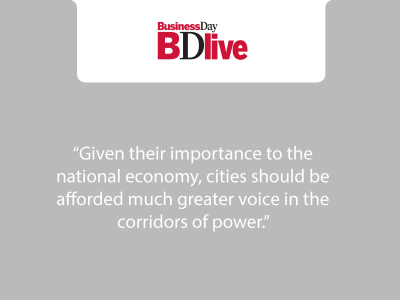
Few people are close to realising the enormous promise arising from proximities in metropolitan areas
About one in every three people who live in SA’s metros has a job. This is low in comparison with other developing countries. But compare this to our small towns, where one in six has a job, or SA’s rural areas, where the figure falls to an all-but-unbelievable one in 20, and SA’s cities reveal themselves for what they could become: places where the poor can find opportunity, and which hold out the prospect of relative prosperity for all.
Cities as arenas of economic opportunity derive from their nature as places where people live in proximity to each other. By shrinking the space between people, cities allow people to work together, and for each other much more efficiently than is possible in low-density environments. This encourages much deeper and more extensive specialisation in skills and economic activity, which in turn allows people and firms to get better and better at solving problems and delivering goods and services.
As labour markets, cities allow firms and workers to find each other more efficiently, boosting productivity. The proximity of firms also means that competitive pressures are maximised and that new ideas, new ways of doing things and new technologies can diffuse rapidly.
This is the promise of cities. While SA’s cities perform better than its rural areas, few would argue that they are performing anywhere close to their enormous economic and developmental potential. The reasons are many and also interrelated and mutually reinforcing with roots in our complex history.
The apartheid state resisted urbanisation and, through policies of segregation and exclusion — to say nothing of discriminatory educational practices and race-based exclusion from economic opportunity — ensured that the spatial structure of cities failed to capture most of the economic benefits that urbanisation can deliver. While progress has been made, it is fair to say that this legacy persists. This can be seen in racially and economically divided residential patterns, low densities and huge differentials in infrastructure provision between many townships and suburbs.
Low densities combined with the large numbers of people who live on urban peripheries, far from employment opportunities, many in postapartheid developments, has knock-on effects on the viability, availability and affordability of public transport, which eats into poor households’ disposable incomes and raises jobseekers’ reservation wages. They also create deep distortions in housing markets, compounded by insecure property rights in many poor areas, that make upward mobility far harder than it should be as a result of steep rises in housing costs in better-located and better-serviced areas.
These historical causes of poor economic performance and bad socioeconomic outcomes are reinforced by an increasingly obvious challenge: our cities are — for the most part — badly governed. As a result, their infrastructure is crumbling under neglect from local governments that appear to attach little if any importance to their primary service delivery and developmental functions.
Fixing all of this will be challenging, and the precondition for success is that cities’ governance has to improve. If we do not sort out political chaos, corruption and administrative dysfunction, our cities, as economic engines and places for upward mobility for poorer people, will die.
Apart from improving governance, an agenda that drives urban growth would encompass other goals, too. Urban crime levels, for example, are exceptionally high, and impose enormous costs on households and business, especially small and informal businesses. Indeed, crime (coupled with low density) may be a key reason SA’s informal sector is unusually small for a developing country with low levels of formal employment.
Most law enforcement powers vest in the national government, so cities must both support policing and prosecution (for example by implementing technological solutions that make the identification of offenders easier, such as smart CCTV cameras) and campaign vigorously for improved policing or greater control over policing in their jurisdictions.
Cities also need to improve public transport. This is failing most workers and work-seekers because of the cities’ low densities and because policies and institutions — national, provincial and local — responsible for public transport are not fit for purpose. Significant redesign is needed, and city leaders should be screaming from the rooftops for it.
One of the most important changes that cities need to make is their relationship to housing development projects, especially residential development. Here, the cities need to adopt an approach to projects that is biased towards approval and implementation.
The current system of approvals and consultation for projects is slow and cumbersome, and shot through with opportunities for local interest groups to effectively veto development. The result is that projects become more risky (since they may not be approved) and take too long to implement. Finding ways to overcome the inertia and antidevelopment bias set into the system is necessary if faster progress is to be made in transforming cities’ spatial structures.
In this regard, a critical step is for cities to maximise the opportunities for in-fill development, particularly of small-scale rental stock development that has the potential to rapidly increase densities, while also stimulating the small companies (construction, landlords) that now comprise a critical sector of local business.
This would be the fastest and most efficient approach to addressing the cities’ housing crises, which are being deepened rather than alleviated by misconceived proposals to build huge 1990-style RDP developments on the cities’ peripheries. Yes, the land there may be relatively cheap, but it is cheap because it is far from opportunity. Public money should rather go into strengthening city governments to provide and maintain urban infrastructure, especially in the inner cities, and enforcing basic rules to ensure healthy and sustainable development.
Another bad idea that some cities (and provincial governments) have entertained is to commit to the still vague notion of a “township economies agenda”.
While townships face severe infrastructural deficits and investment in municipal infrastructure is desirable, the hope that some combination of regulation and preferential procurement policies can stimulate the rapid diversification and development of economies in low-density dormitory suburbs is flawed. A wealth of international evidence shows that place-based policies only ever succeed in areas that already have relatively dynamic local economies and which would have developed even in the absence of special, place-based policies.
SA’s cities face multiple, overlapping and interconnected challenges. They are, nonetheless, the country’s best hope for turning our economy and our manifold social crises around. With good leadership, decent policies and reasonable honest implementation, urban-led growth could transform the country’s economic prospects and contribute significantly to making SA a more inclusive society.
Given their importance to the national economy, cities should be afforded much greater voice in the corridors of power.
Most importantly, however, they need to be far, far better governed. Managing and leading SA’s metros should not be the political landing space for those who cannot make it in national politics.
Bernstein is executive director of the Centre for Development & Enterprise. This article is based on a report; “SA’s future will be decided in our cities“, commissioned from Economic Research Southern Africa.
Article published by the Business Day Live




